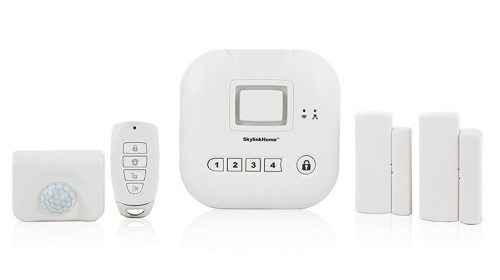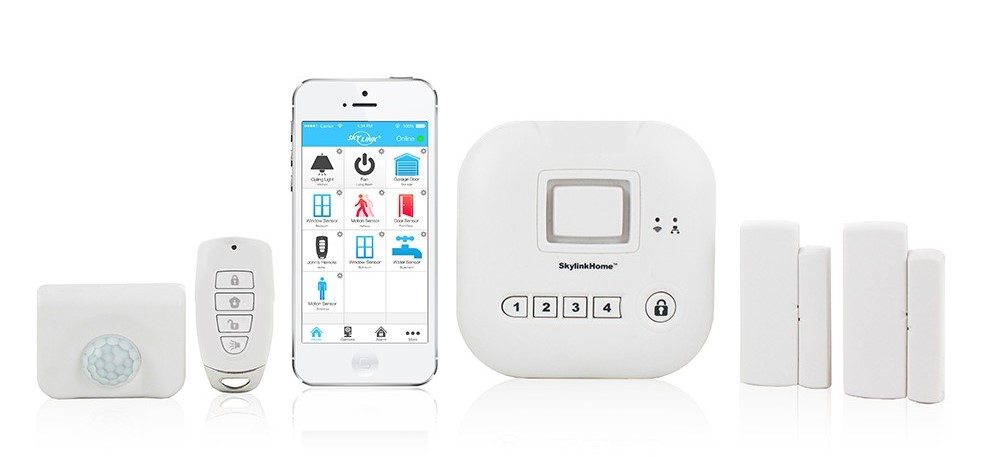In my quest for perfect home automation and security, I have been trying out different avenues. For the most part, you can see where the technology is heading, and the ease of use has been fantastic.
 The Skylink Alarm System Starter Kit wins the “smallest footprint for a starter kit” award. Everything you need comes packaged in a 5-inch cube. The starter kit contains the Internet Hub, two window or door sensors, a motion sensor, a keychain remote, and the necessary cables and mounting accessories. The keychain remote is a nice accessory to have for homes like mine with younger children. The system is completely controlled via a mobile device like a tablet or smartphone, so the remote is great for children who do not have those yet or older folks who simply do not want to fool with one.
The Skylink Alarm System Starter Kit wins the “smallest footprint for a starter kit” award. Everything you need comes packaged in a 5-inch cube. The starter kit contains the Internet Hub, two window or door sensors, a motion sensor, a keychain remote, and the necessary cables and mounting accessories. The keychain remote is a nice accessory to have for homes like mine with younger children. The system is completely controlled via a mobile device like a tablet or smartphone, so the remote is great for children who do not have those yet or older folks who simply do not want to fool with one.
The Internet Hub is the brain of the system and connects directly to the home’s router. It coordinates the activities of all sensors and receivers wirelessly and transmits that data to the system’s available smartphone app. The Internet Hub comes with an 110dB Built-in Siren, a Backup Battery feature in case of power outages, and a 4-Button Keypad to arm and disarm your alarm system. Of the different units that I have reviewed, this is the only one that includes a signal alarm with the basic starter kit. It is also important to know that the Skylink system does not notify the authorities by default. This is a HUGE factor for me due to the fact that false alarms can cost money, and, when you have kids and/or pets that can trigger alarms often, that can be expensive. Also, this is an internal alarm. It is loud enough to be heard throughout the home but not bother the neighbors. The Skylink has all of those types of add-ons available, but, for most people, a house full of blasting sirens is enough of a deterrent to breaking and entering.
Speaking of add-ons, the system can facilitate up to 100 additional sensors and controllers for home automation. For my home, using just the basic box with no additional units, I have covered the front door with a trip sensor; the back door with a trip sensor; and the hallway to the garage with a motion sensor. Therefore, with this minimal setup and one time cost, my home is totally protected from entering or exiting through a door. According to burglary studies, the majority of break-ins happen by way of a door. Even if they come through a window, in order to steal anything of real size, they will need to exit via a doorway. Of course, for a minimal additional cost that could be remedied with an additional motion sensor in the living room or window trip alarms.

The biggest advantage of this system over the others reviewed is the cost. The Skylink Starter System retails for under $150 and there are no monthly fees. That is correct. No $9.99 or $4.99 per month. This is the only system reviewed that has no recurring expense. Also, the additional accessories and sensors are about half the cost of others reviewed. Let’s face it, the reason you are installing a unit like this yourself (DIY) is because you want to save on the installation cost. Why not get a system that is cost appropriate and functional too?
To find out more about the Skylink System, or purchase, visit: www.Skylinkhome.com.
Here is an informational video from their website featuring the Starter System and many additional accessories.
Disclosure: A Skylink Starter System was provided for review purpose, but the opinion expressed is my own.





iSmart Alarm also has no recurring fees. I’ve been using it for a couple years, and overall, I’m pleased. I’d love to hear a comparison of the various DIY security systems, since most reviews seem to live in a vacuum.